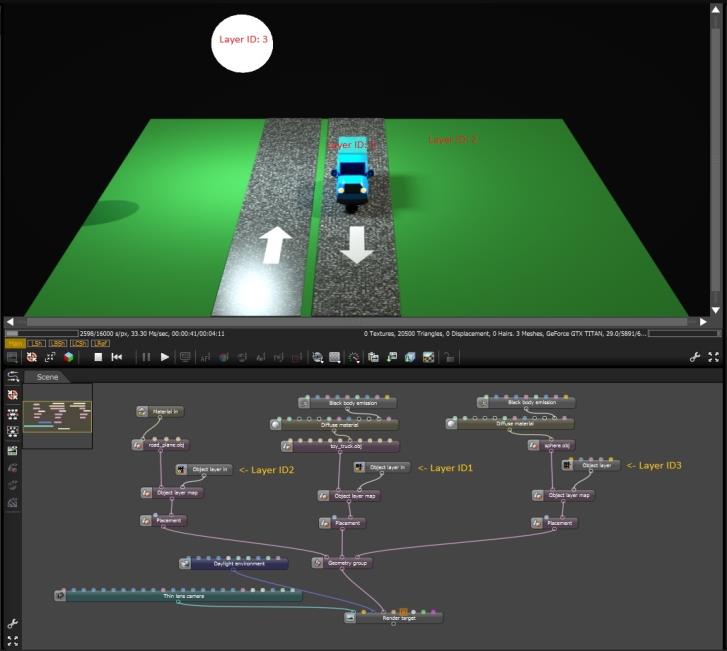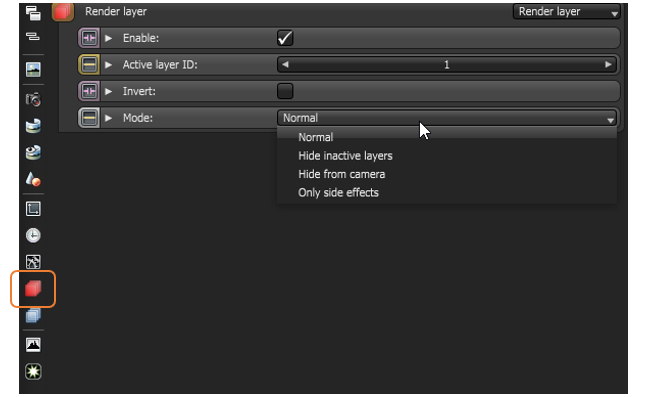
Render layers allow users to separate their scene geometry into parts, where one part is meant to be visible and the rest of the parts “capture” the side effects of the visible geometry on it. The layers allow different objects to be rendered into separate images where in turn some normal render passes may be applied.
The Render layers are meant for compositing and not to hide parts of the scene itself. In the scene, users would either disconnect the geometry (so it does not render) or use the general visibility in the Object Layer node.
To set up a scene for rendering in layers, an Object Layer Map node is used to connect an Object node to an Object Layer node, where one can assign the layer ID for that object (Figure 1).

Figure 1: Render layers are created by assigning render layer IDs to the nodes you wish to isolate
With the Layer ID for objects in the scene assigned, users may proceed to specifying the active render layer. This can be done through the active Render Layer node, which connects the active layer to the Render Target (Figure 2).

Figure 2: The attributes for the Render layer node
Mode
This determines the visibility mode that should be used to render layers.
• Normal – The beauty passes contain the active layer only and the render layer passes (shadows, reflections...) record the side-effects of the active render layer for those samples/pixels that are not obstructed by the active render layer. Beauty passes will be transparent for those pixels which are covered by objects on the inactive layers, even if the is an object on the active layer behind the foreground object.
• Hide inactive layers – All geometry that is not on an active layer will be made invisible and no side effects will be recorded in the render layer passes, i.e. the render layer passes will be empty.
• Only side effects – Similar to ‘Normal’, with the exception that the active layer will be made invisible to the camera, i.e. the beauty passes will be empty. The render layer passes (shadows, reflections...) still record the side effects of the active render layer. This is useful to capture all side effects without the active layer obstructing those.
• Hide from cameras – Similar to ‘Hide inactive layers’, all geometry that is not on an active layer will be made invisible but side effects (shadows, reflections...) will be recorded in the render layer passes.
The main beauty pass will render only this active layer and cut out everything else, users can also choose to invert everything by toggling Invert in the render layer node. The real power of the render layer feature is in the shadow and reflection layer passes, where the “side effects” of the render layer are captured. They allow users to compose the render layer on some background with shadows and reflections.
OctaneRender distinguishes shadows as either of two shadow types: “black shadows” and “colored shadows”.
Black shadows are caused by opaque materials or specular materials that do not have the “fake shadow” option enabled. They are what the matte material is capturing and can be composed using normal alpha blending.
Colored shadows are shadows that are cast by specular materials with the “fake shadow” option enabled (Figure 3).

Figure 3: The shadow settings for render layers
Shadows
Combines black shadows (in the alpha channel) with colored shadows (in the RGB channels) in a single image. The blend mode is multiply.
Black Shadows
Captures black shadows, this pass only uses the alpha channel and should be composited via the normal blend mode (regular alpha blending).
Colored Shadows
Captures colored shadows cast by objects on the active layer geometry. Only objects with a specular material with fake shadows enabled can cast colored shadows. This pass doesn’t have an alpha channel and should be composed in via the multiply blend mode.
Reflections
Captures light reflected off of objects on the active layer on objects on the non-active layers. This pass respects the materials so the look of the reflections really depends on the materials used.